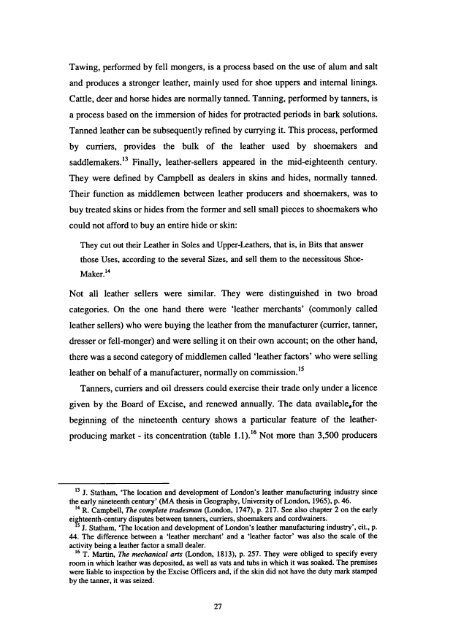The Boot and Shoe Trades in London and Paris in the Long Eighteenth Century
The Boot and Shoe Trades in London and Paris in the Long Eighteenth Century
The Boot and Shoe Trades in London and Paris in the Long Eighteenth Century
You also want an ePaper? Increase the reach of your titles
YUMPU automatically turns print PDFs into web optimized ePapers that Google loves.
Taw<strong>in</strong>g, performed by fell mongers, is a process based on <strong>the</strong> use of alum <strong>and</strong> salt<br />
<strong>and</strong> produces a stronger lea<strong>the</strong>r, ma<strong>in</strong>ly used for shoe uppers <strong>and</strong> <strong>in</strong>ternal l<strong>in</strong><strong>in</strong>gs.<br />
Cattle, deer <strong>and</strong> horse hides are normally tanned. Tann<strong>in</strong>g, performed by tanners, is<br />
a process based on <strong>the</strong> immersion of hides for protracted periods <strong>in</strong> bark solutions.<br />
Tanned lea<strong>the</strong>r can be subsequently ref<strong>in</strong>ed by curry<strong>in</strong>g it. This process, performed<br />
by curriers, provides <strong>the</strong> bulk of <strong>the</strong> lea<strong>the</strong>r used by shoemakers <strong>and</strong><br />
saddlemakers.' 3 F<strong>in</strong>ally, lea<strong>the</strong>r-sellers appeared <strong>in</strong> <strong>the</strong> mid-eighteenth century.<br />
<strong>The</strong>y were def<strong>in</strong>ed by Campbell as dealers <strong>in</strong> sk<strong>in</strong>s <strong>and</strong> hides, normally tanned.<br />
<strong>The</strong>ir function as middlemen between lea<strong>the</strong>r producers <strong>and</strong> shoemakers, was to<br />
buy treated sk<strong>in</strong>s or hides from <strong>the</strong> former <strong>and</strong> sell small pieces to shoemakers who<br />
could not afford to buy an entire hide or sk<strong>in</strong>:<br />
<strong>The</strong>y cut out <strong>the</strong>ir Lea<strong>the</strong>r <strong>in</strong> Soles <strong>and</strong> Upper-Lea<strong>the</strong>rs, that is, <strong>in</strong> Bits that answer<br />
those Uses, accord<strong>in</strong>g to <strong>the</strong> several Sizes, <strong>and</strong> sell <strong>the</strong>m to <strong>the</strong> necessitous <strong>Shoe</strong>-<br />
Maker.'4<br />
Not all lea<strong>the</strong>r sellers were similar. <strong>The</strong>y were dist<strong>in</strong>guished <strong>in</strong> two broad<br />
categories. On <strong>the</strong> one h<strong>and</strong> <strong>the</strong>re were 'lea<strong>the</strong>r merchants' (commonly called<br />
lea<strong>the</strong>r sellers) who were buy<strong>in</strong>g <strong>the</strong> lea<strong>the</strong>r from <strong>the</strong> manufacturer (currier, tanner,<br />
dresser or fell-monger) <strong>and</strong> were sell<strong>in</strong>g it on <strong>the</strong>ir own account; on <strong>the</strong> o<strong>the</strong>r h<strong>and</strong>,<br />
<strong>the</strong>re was a second category of middlemen called 'lea<strong>the</strong>r factors' who were sell<strong>in</strong>g<br />
lea<strong>the</strong>r on behalf of a manufacturer, normally on commission.'5<br />
Tanners, curriers <strong>and</strong> oil dressers could exercise <strong>the</strong>ir trade only under a licence<br />
given by <strong>the</strong> Board of Excise, <strong>and</strong> renewed annually. <strong>The</strong> data available,for <strong>the</strong><br />
beg<strong>in</strong>n<strong>in</strong>g of <strong>the</strong> n<strong>in</strong>eteenth century shows a particular feature of <strong>the</strong> lea<strong>the</strong>r-<br />
produc<strong>in</strong>g market - its concentration (table 1.1).16 Not more than 3,500 producers<br />
13 j Statham, '<strong>The</strong> location <strong>and</strong> development of <strong>London</strong>'s lea<strong>the</strong>r manufactur<strong>in</strong>g <strong>in</strong>dustry s<strong>in</strong>ce<br />
<strong>the</strong> early n<strong>in</strong>eteenth century' (MA <strong>the</strong>sis <strong>in</strong> Geography, University of <strong>London</strong>, 1965), P. 46.<br />
' R. Campbell, <strong>The</strong> complete tradesman (<strong>London</strong>, 1747), p. 217. See also chapter 2 on <strong>the</strong> early<br />
eihteenth-century disputes between tanners, curriers, shoemakers <strong>and</strong> cordwa<strong>in</strong>ers.<br />
J. Statham, '<strong>The</strong> location <strong>and</strong> development of <strong>London</strong>'s lea<strong>the</strong>r manufactur<strong>in</strong>g <strong>in</strong>dustry', cit., p.<br />
44. <strong>The</strong> difference between a 'lea<strong>the</strong>r merchant' <strong>and</strong> a 'lea<strong>the</strong>r factor' was also <strong>the</strong> scale of <strong>the</strong><br />
activity be<strong>in</strong>g a lea<strong>the</strong>r factor a small dealer.<br />
16<br />
T. Mart<strong>in</strong>, <strong>The</strong> mechanical arts (<strong>London</strong>, 1813), p. 257. <strong>The</strong>y were obliged to specify every<br />
room <strong>in</strong> which lea<strong>the</strong>r was deposited, as well as vats <strong>and</strong> tubs <strong>in</strong> which it was soaked. <strong>The</strong> premises<br />
were liable to <strong>in</strong>spection by <strong>the</strong> Excise Officers <strong>and</strong>, if <strong>the</strong> sk<strong>in</strong> did not have <strong>the</strong> duty mark stamped<br />
by <strong>the</strong> tanner, it was seized.<br />
27


